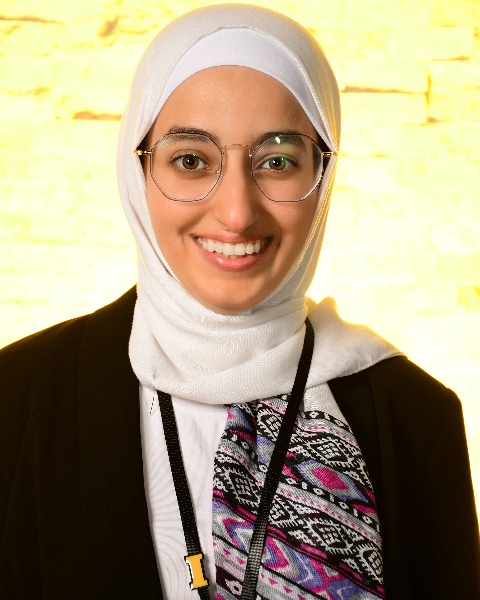Physiologically Based Pharmacokinetics
(M-003) Determining an Appropriate Fosfomycin Dosing Regimen in Pneumonia Patients by Utilizing minimal PBPK Modeling and Target Attainment Analysis
Monday, November 11, 2024
7:00 AM - 5:00 PM MST
Guohua An, MD/Ph.D – Associate Professor, Department of Pharmaceutical Sciences and Experimental Therapeutics, College of Pharmacy, University of Iowa, Iowa city, IA, USA.; Kenan Gu, MD/Ph.D – Pharmacologist, Division of Microbiology and Infectious Diseases, National Institute of Allergy and Infectious Diseases, Rockville, MD, USA; Xuanzhen Yuan, MS – Ph.D student, Department of Pharmaceutical Sciences and Experimental Therapeutics, College of Pharmacy, University of Iowa, Iowa city, IA, USA.; Joshua Reeder, BS – Ph.D student, Department of Pharmaceutical Sciences and Experimental Therapeutics, College of Pharmacy, University of Iowa, Iowa city, IA, USA.

Jomana Al Hroot (she/her/hers)
Ph.D student
University of Iowa
Iowa City, Iowa, United States
Author(s)
Disclosure(s):
Jomana Al Hroot: No financial relationships to disclose
Objective: Antimicrobial resistance (AMR) poses a significant global health threat, especially with pathogens like the ESKAPE group, known for causing severe infections, including pneumonia, a lower respiratory tract infection (1). Fosfomycin has been reported to treat such kind of resistant pathogens (2) and is known to rapidly penetrate the lungs (3). Due to these facts, the NIH conducted a phase 1 clinical study on fosfomycin (ZTI-01). Thirty healthy participants were given 6 g dose every 8 hours via IV infusion. Blood samples were collected after the first and third doses, while intrapulmonary samples, the Epithelial Lining Fluid (ELF) and Alveolar Macrophages (AM) were obtained after the third dose. This project aims to propose an appropriate dosing regimen for fosfomycin to be used in a phase 2 clinical study by using a mechanistic, minimal physiologically based pharmacokinetics (minimal PBPK) model to predict drug concentrations in plasma, and in major infection sites like the ELF and AM. Furthermore, it examines changes in drug concentration during infection and predicts the probability of target attainment (PTA) of fosfomycin to identify optimal dosing regimens for pneumonia patients.
Methods: Different models were evaluated, and among them, the minimal PBPK model successfully captured drug concentrations in plasma, ELF, and AM. The model consisted of Plasma, Tissue, and Lung compartments. The Lung compartment includes lung tissues, Interstitial Fluid (ISF), ELF, and AM. The volumes of these compartments were fixed to physiological values; specifically, ISF, ELF, and AM were set to 0.026, 0.0026, and 0.3 L, respectively. Monte Carlo simulations were conducted to evaluate pneumonia's impact on drug concentrations at the infection site and PTA against various pathogens. NONMEM 7.4.3 was used for minimal PBPK model estimation and simulation.
Results: The PK parameters of the proposed model were estimated. The systematic clearance was 6.17 L/hr, the permeability surface product (PS) between the ISF and ELF was 0.0316 L/hr. The partition coefficients in the ELF and lung tissues were 0.39 and 11.6, respectively. During the infection, these parameters change, but this doesn't always alter infection site concentrations. Increased alveolar membrane permeability didn't affect drug levels there. However, changes in ELF volume and partition coefficients reduced drug concentrations.
Plasma data alone overestimated the effectiveness, as concentrations in the ELF and AM were lower compared to plasma, with further reductions in pneumonia patients. Therefore, the dose used in phase1 study didn’t achieve the PK/PD target and a higher dose should be considered in the subsequent trial.
Conclusion: Our model structure can also be also used to study intrapulmonary pharmacokinetics for other antibiotics. Additionally, our PTA results can guide physicians in dosing decisions for different pneumonia stages.
Citations: 1. Torres A, Cilloniz C, Niederman MS, Menendez R, Chalmers JD, Wunderink RG, van der Poll T. Pneumonia. Nat Rev Dis Primers. 2021;7(1):25.
2. Pulcini C, Bush K, Craig WA, Frimodt-Moller N, Grayson ML, Mouton JW, et al. Forgotten antibiotics: an inventory in Europe, the United States, Canada, and Australia. Clin Infect Dis. 2012;54(2):268-74.
3. Falagas ME, Giannopoulou KP, Kokolakis GN, Rafailidis PI. Fosfomycin: use beyond urinary tract and gastrointestinal infections. Clin Infect Dis. 2008;46(7):1069-77.

